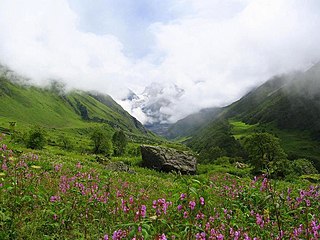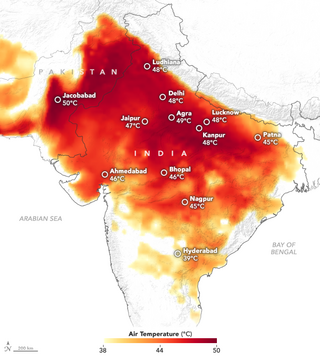India
Heat-related deaths were reported from the capital New Delhi, northern Haryana, Uttar Pradesh, Rajasthan and Madhya Pradesh. After three days of intense heat with temperatures hovering about 40 °C (104 °F), New Delhi was relieved as the temperature slid down to 37.2 °C (99.0 °F). [1] Meanwhile, the temperature soared to more than 46 °C (115 °F) at several places in northern Madhya Pradesh, with Datia turning out to be the hottest at 48 °C (118 °F). [2]
More than 120 peacocks died in Tughlaqabad Fort and Surajkund due to the heat; additionally, reports of severe water shortages were common. [3] A total of 400 peacocks died in Madhya Pradesh, about 200 of those in Haryana and Punjab alone. [3]
The cotton crop in Punjab was severely affected by the heat wave. [4] Meanwhile, the persisting heat wave in various parts of Chandigarh rendered milk cattle dry. When the day temperature hovered around +48 °C (118 °F), milk supply to various milk plants of cooperative unions went down by 40,000 litres (11,000 US gallons) per day. [5] In addition, milk collection by private-sector plants was reduced by 160,000 litres (42,000 US gallons) during the same period. [5]

A heat wave, sometimes described as extreme heat, is a period of abnormally hot weather. Definitions vary but are similar. A heat wave is usually measured relative to the usual climate in the area and to normal temperatures for the season. Temperatures that humans from a hotter climate consider normal, can be regarded as a heat wave in a cooler area. This would be the case if the warm temperatures are outside the normal climate pattern for that area. High humidity often occurs during heat waves as well. This is especially the case in oceanic climate countries. Heat waves have become more frequent, and more intense over land, across almost every area on Earth since the 1950s. Heat waves occur from climate change.

The climate of India consists of a wide range of weather conditions across a vast geographic scale and varied topography. Based on the Köppen system, India hosts six major climatic sub types, ranging from arid deserts in the west, alpine tundra and glaciers in the north, and humid tropical regions supporting rain forests in the southwest and the island territories. Many regions have starkly different microclimates, making it one of the most climatically diverse countries in the world. The country's meteorological department follows the international standard of four seasons with some local adjustments: winter, summer, monsoon or rainy season, and a post-monsoon period.

The Loo is a strong, dusty, gusty, hot and dry summer wind from the west which blows over the Indo-Gangetic Plain region of North India and Pakistan. It is especially strong in the months of May and June. Due to its very high temperatures, exposure to it often leads to fatal heatstrokes.
Delhi features a dry winter humid subtropical climate bordering a hot semi-arid climate, with high variation between summer and winter temperatures and precipitation. Delhi's version of a humid subtropical climate is markedly different from many other humid subtropical cities such as São Paulo, Houston, and Brisbane in that the city features dust storms and wildfire haze due to its semi-arid climate.

Pakistan's climate varies from a continental type of climate in the north, a mountainous dry climate in the west (Baluchistan), a wet climate in the East (Punjab) an arid climate in the Thar Desert, to a tropical climate in the southeast (Sindh), characterized by extreme variations in temperature, both seasonally and daily, because it is located on a great landmass barely north of the Tropic of Cancer.
Sattu is a type of flour, mainly used in India, Nepal, Tibet and Pakistan. Sattu is a type of flour made up of dry roasted and ground pulses and cereals. The dry powder is prepared in various ways as a principal or secondary ingredient of dishes. Sattu is used in vegetarian cuisine as it can be a source of protein.
More than 1,030 people were killed in the 2002 heatwave in South India. Most of the dead were poor and elderly and a majority of deaths occurred in the southern state of Andhra Pradesh. In the districts that were impacted most, the heat was so severe that ponds and rivers evaporated and in those same districts birds had fallen from the sky and animals were collapsing from the intense heat.

The 2010 Northern Hemisphere summer heat waves included severe heat waves that impacted most of the United States, Kazakhstan, Mongolia, China, Hong Kong, North Africa and the European continent as a whole, along with parts of Canada, Russia, Indochina, South Korea and Japan during July 29 2010. The first phase of the global heatwaves was caused by a moderate El Niño event, which lasted from June 2009 to May 2010. The first phase lasted only from April 2010 to June 2010, and caused only moderate above average temperatures in the areas affected. But it also set new record high temperatures for most of the area affected, in the Northern Hemisphere. The second phase was caused by a very strong La Niña event, which lasted from June 2010 to June 2011. According to meteorologists, the 2010–11 La Niña event was one of the strongest La Niña events ever observed. That same La Niña event also had devastating effects in the Eastern states of Australia. The second phase lasted from June 2010 to October 2010, caused severe heat waves, and multiple record-breaking temperatures. The heatwaves began in April 2010, when strong anticyclones began to develop, over most of the affected regions, in the Northern Hemisphere. The heatwaves ended in October 2010, when the powerful anticyclones over most of the affected areas dissipated.
Quetta, Pakistan features a continental semi-arid climate with a large variation between summer and winter temperatures. The highest temperature recorded in Quetta was 42 °C (108 °F) on 10 July 1998. The lowest temperature in Quetta is −18.3 °C (−0.9 °F) which was recorded on 8 January 1970.
The climate of Uttar Pradesh (U.P.) is primarily defined as humid subtropical with dry winter (Cwa) type with parts of Western U.P. as hot semi-arid (BSh) type. Alternatively, some authors refer to it as tropical monsoon. Variations do exist in different parts of the large state. However, the uniformity of the vast Indo-Gangetic Plain forming the bulk of the state gives a predominantly single climatic pattern to the state with minor regional variations. U.P. has a climate of extremes. With temperatures fluctuating anywhere from 0 °C or 32 °F to 50 °C or 122 °F in several parts of the state and cyclical droughts and floods due to unpredictable rains, the summers are extremely hot, winters are cold and the rainy season can be either very wet or very dry.
In May 2015, India was struck by a severe heat wave. As of 3 June 2015, it caused the deaths of at least 2,500 people in multiple regions. The heat wave occurred during the Indian dry season, which typically lasts from March to July with peak temperatures in April and May. Although it typically remains hot until late October, Indian monsoons often provide some respite from the heat.
The 2016 Indian heat wave was a major heat wave in April and May of that year. A national record high temperature of 51.0 °C (123.8 °F) was set in the town of Phalodi, in the state of Rajasthan. Over 1,100 people died with 330 million affected to some degree. There were also water shortages with drought worsening the impact of the heat wave.

North India was devastated by a cold wave during the month of January 2017. This occurrence had a severe effect on several North Indian states, including Himachal Pradesh, Jammu and Kashmir, Punjab, Haryana, Rajasthan, and Uttar Pradesh. The lowest temperature in Gulmarg due to the cold wave was recorded at −12.4 °C (9.7 °F). The banks of Dal Lake in Srinagar froze. Keylong of Himachal Pradesh and Kargil of Jammu and Kashmir witnessed low temperatures of −13.9 °C (7.0 °F).

From mid-May to mid-June 2019, the republics of India and Pakistan had a severe heat wave. It was one of the hottest and longest heat waves in the subcontinent since the two countries began recording weather reports. The highest temperatures occurred in Churu, Rajasthan, reaching up to 50.8 °C (123.4 °F), a near record high in India, missing the record of 51.0 °C (123.8 °F) set in 2016 by a fraction of a degree. As of 12 June 2019, 32 days are classified as parts of the heatwave, making it the second longest ever recorded.

In 2022, several areas of the world experienced heat waves. Heat waves were especially notable in East Asia, the Indian subcontinent, Australia, western Europe, the United States, and southern South America. 2022 heat waves accounted for record-breaking temperatures and, in some regions, heat-related deaths. Heat waves were worsened by the effects of climate change, and they exacerbated droughts and wildfires.

The 2022 India–Pakistan heat wave was an extreme weather event which resulted in the hottest March in the subcontinent since 1901. The hot season arrived unusually early in the year and extended into April, affecting a large part of India's northwest and Pakistan. The heatwave was combined with a drought, with rainfall being only a quarter to a third of normal. It occurred during a La Niña event, in which heat records are generally less likely.
Starting in April 2023, a record-breaking heat wave has affected many Asian countries, including India, Sri Lanka, Bangladesh, Cambodia, China, Laos, Thailand, Malaysia, Singapore and Vietnam. Several regional temperature records have been set. The heat wave has caused many deaths due to heat stroke and has prompted health warnings and power outages across multiple countries.









